Ms 791 b, c, d og e. - Justinian's Digest with glosses by Accurtius
- tilpass zoom
- forrige
- gå til side av
- neste
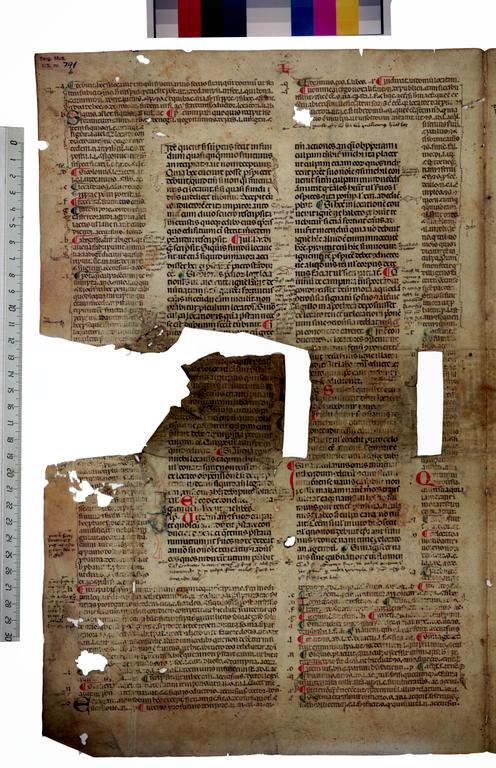
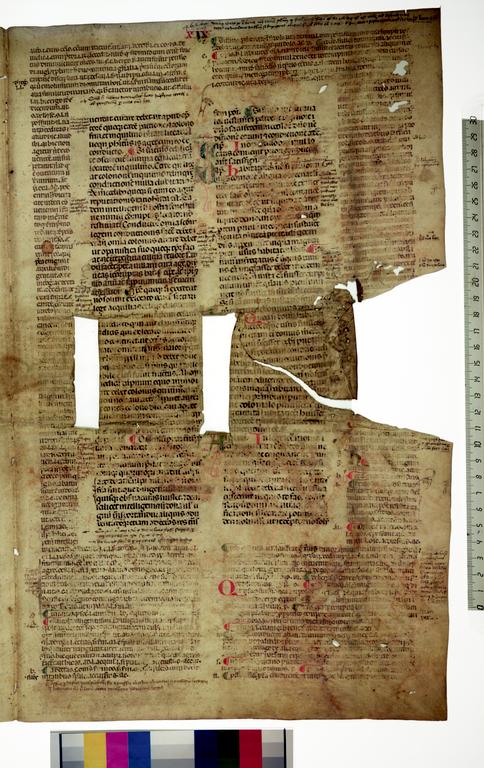


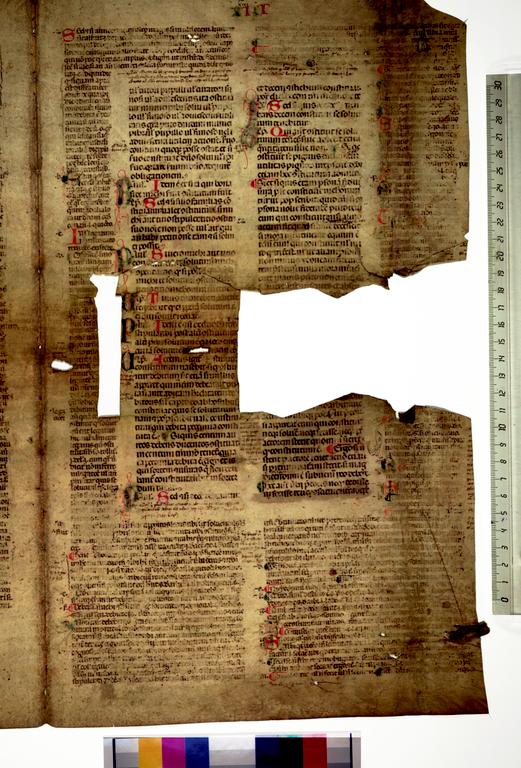

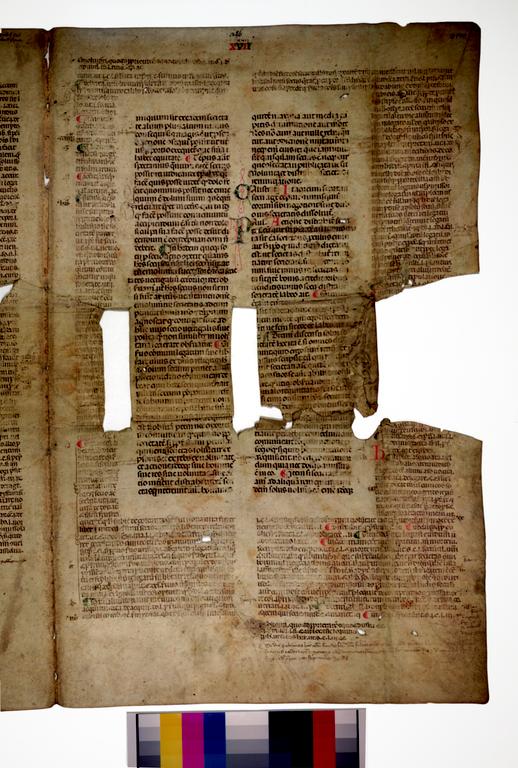
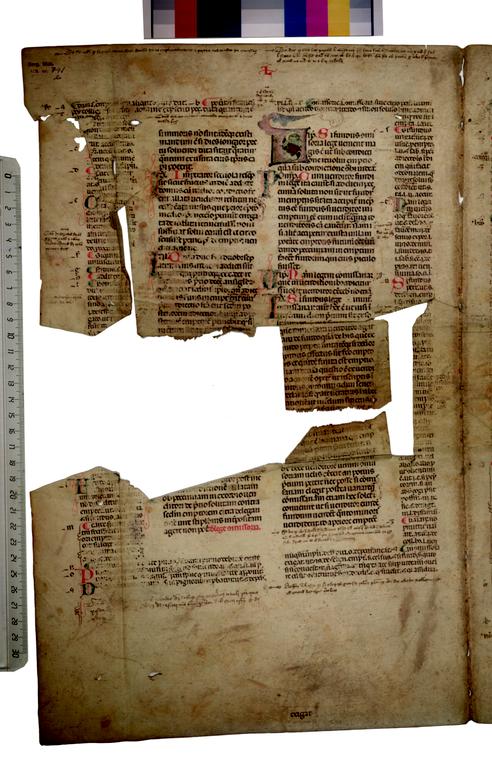

MS 791, b-e are from a glossed version of Justinian’s Digest, which was one of the pillars of the Corpus iuris civilis, a collection of laws put together by the emperor Justinian for the Eastern Roman empire during the years 529-534 AD. The digests were extracts from former writings on Roman law. About 2000 books from 39 different authors were used as sources, and the selected items were organized in 50 books. Among the fragments belonging to MS 791 we have parts from the books 13 and 14 (fragment d), 17 (e), 18 (c) and 19 (b). Not much else was known about these fragments until a workshop on manuscript fragments was held in Bergen, in late October 2005. Here the fragments were dated to the 14th century, and identified as a product of the Italian town of Bologna, which in the Middle ages was known for its university and excellence in lawstudies. The fragments in the University Library of Bergen most probably came from a manuscript produced by one of the teams working in connection with the University. The name “dominus Accurtius” is mentioned in one of the lower margins of fragment c, referring to Franciscus Accurtius (d. 1260), one of the most famous glossators in Bologna. He compiled his work between 1220 and 1240, and his glosses became standard for the Corpus Iuris Civiles for centuries. We are grateful to David Ganz (London) for the information about the origin of these fragments.
Parchment, four bifolia, leaf size: ca. 42 x 27 cm, and two smaller fragments, ca. 6,5 x 9 cm. Quires: There are bifolia from four different quires: Fragment d has the lowest folionumber, f. 186. This bifolium was the first one in its quire of four (a quaternion), starting with f. 186, ending with f. 193, i.e. the three quires going from 187-192 are missing. In the centre of the lower margin of f. 193v is a framed catchword, “liberis”. Next to it is a small roman numeral: lviiii. It seems that the flesh-side of the parchment originally faced outwards in the quire. (Note that the bifolium today is folded the opposite way.) The order of the next fragments are: Fragm. e – c – b. They seem to come from three different quires, going from f. 236-f. 262. Fragment e was the first bifolium in its quire, starting with f. 236. The last folionumber is unfortunately difficult to read. In the centre of the lower margin of the last folio of fragment c is a framed catchword, “exigat”. Next to it is a small roman numeral: xlviiii. It seems that the flesh-side of the parchment originally faced outwards in the quire. (Note that the bifolium today is folded the opposite way.) The fragments c and b seem not to have been the first or last bifolia in their quires. They have no catchwords, and the contents does not indicate that any of the folia are particularly close together. Lay-out: Two double, “onion-layered” columns: Complete writing space is ca 39 x 23,5 cm. The main text of Justinian, in larger script, appears in two columns of ca 25/26 x 6,5 cm, imbedded in two larger columns of smaller script. The outer column of the gloss-text is ca 39,5 x 12 cm, while the column of the gloss-text closer to the spine is only 10 cm wide. The main text has 48-50 lines, while the glosses have ca 70-90 lines to the page. The ruling for the main text seems to be very thin lead ruling (the colour is grey, not the ink-colour). The ruling for the glosses is not visible. Fragment b is marked XIX on the top of the recto-pages, and L on the verso-pages, in roman red and blue numerals. The number 262 is written above the second recto. Fragment c is marked XIX on the first recto-page, and L on the first verso. The second recto is marked XVIII, with the later number 248 (?) written above it. The marking of the second verso is not visible. Fragment d is marked XIIII on the first recto-page, with the folionumber 193 noted above, while the first verso is marked L. The second recto is marked XIII with 186 noted above. The marking of the second verso is not visible. Fragment e: The first recto is marked XVIII. The number above is not readable. The first verso is marked L. The second verso is marked XVII, with the number 236 written above it. The roman numerals on the recto-side refer to the books from Justinian’s digest, while the arabic numbers above them seem to mark the folia. There are rubrics marking the different chapters in the books. Script: A southern Gothic textualis formata. Initials: Two multicoloured initials in very fine execution, with red, pink, light and dark blue, white and gold. In one instance the white plaster can be seen through the gold. The other initials are fleuronnée, mainly blue with red flourishing. The first initial is a G (in Gaius), marking the transition from book 14, 1 to 14, 2 (fragm. d, fol. 193v). The second initial is a U (in Ulpianus), marking the transition from book 18, 2 to 18, 3 (fragm. e). Condition: The leaves are cut to serve as book covers, and are quite damaged. The outer sides of the bifolia are very faded, and only very week remnants of script are left, along with some hints of red colour. Going from one side to another are four rectangular holes, ca. 6,5 x 1,5 cm, marking the spine of the later covered book. There are also holes from worms or insects. Where the parchment would cover the later spine, fragment b is marked “Baldus”, probably referring to Baldus de Ubaldis. The number 45 is crossed over and below is written the number 15. Fragment c is marked “Paulus de Castro”, the number 21 (crossed over) and below, 18. One of two small fragments put together with c is marked “Jacobus Alva rottus super Feudis”, and the number 44 (crossed over). Fragment d is marked “Pars Pauli de Castro”, and the number 26. (crossed over), and below, 15, along the spine of the later binding. For the names referring to the covered books, see secondary provenance. The numbers marking the codices are ca 3,5 cm tall.Dette bildet er en del av utstillingen Fragmenter fra middelalderen
Er en del av
5 membranfragmenter på latin, med delvis illuminerte begyndelsesbokstaver.
Antagelig fra ca. 1300-1400-årene. Hvert enkelte fragment er på baksiden ... se mer
Fysisk beskrivelse
- Parchment, one cropped bifolium, ca. 40, 5 x 25,5 cm Lay-out: Writing space, 32,5 x 19, 5. Two columns 32,5 x 8, 5 cm. 78 lines. The ruling is not visible. Script: A smaller southern Gothic textualis currens. There are paragraphs in alternately red and blue. The marginal notes are in a cursive script, and there is also the drawing of a face. Initials: On the outer side of the bifolium are the remains of the red flourishing from two initials, now missing. Condition: The fragment has been cut to serve as a book cover. In addition it is torn, so that the half of one of the leaves is missing. On the outer side of the bifolium the ink has turned a pale green, except a zone in the middle of the fragment, following the spine of the book it covered. Along the same zone, from one side to another, are four rectangular holes from the binding, ca 5,5 x 1,5 cm. Here the fragment is marked with the number 14., ca. 3,5 cm high. Some small leather “flaps” are still in place, inserted in the parchment.
Sitering
Wikipedia
{{cite web |url=https://marcus.uib.no/instance/fragment/ubb-ms-0791-b |title=Ms 791 b, c, d og e. - Justinian's Digest with glosses by Accurtius |author=Avdeling for spesialsamlinger |accessdate=Fri Apr 19, 2024 |publisher=University of Bergen Library}}